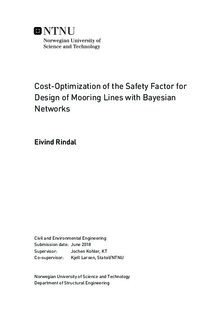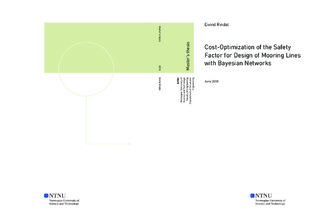| dc.description.abstract | The structural integrity of mooring lines is critical for the safety of offshore facilities. In recent years, concerns have been raised in the offshore industry about the high failure rates compared to the design expectations, in particular in the first years of service. This motivates a review of the design procedures and inspection and maintenance policies. Research is to be conducted to provide insight into the causes of failure as support for better decision-making.
This Thesis investigates how aspects of mooring line design and integrity management of mooring lines can be coupled with decision theory and structural reliability methods to address the optimal safety factor based on risk-informed cost optimization. Three research objectives have been formulated to aid achieving the overarching objective: (1) to represent the current design practice as a decision graph; (2) to represent the current inspection and maintenance routines as a decision graph; (3) to assess the sensitivity of decision outcomes towards the various influencing variables, and estimate the gain of acquiring additional information. Relevant events, decision alternatives, consequences, random variables and their associated uncertainties have to be explored upfront as a prerequisite for the modeling.
The software GeNIe is used to create decision graphs for the design phase. The resulting networks represent the ultimate and accidental limit state. The fatigue limit state is not addressed in this study. The series effect of the line components is neglected, and the decisions kept to a minimum, accounting only for the grade, diameter, and consequence class. Cost-optimization curves are derived from the decision graphs. Results show that the optimal safety factors, in general, are below the values provided by ISO 19901-7.
It is attempted to model the inspection phase as dynamic decision graph in GeNIe. Since dynamic decision graphs are currently not supported in the software, two potential solutions are pursued. The first approach is to create an unrolled version of the network, and the second approach is to use chance nodes as proxies for the decision nodes and to subsequently compute the expected cost manually. It is concluded that both approaches are not feasible without considerable effort; therefore, further investigation of the topic is suspended.
A sensitivity analysis with respect to the failure event is conducted for the design phase networks. Diameter is found to be the most influential parameter, followed by the loads, corrosion rates, and chosen grades. The value of information analysis shows a larger expected gain when the system effects are neglected. This may be due to the assumed independence for corrosion rates and service life between the mooring lines. When system effects are neglected, it is preferred to obtain perfect information on the loads or corrosion rates, while when accounted for, observing loads is the least preferred strategy. | |

